Pumpkin cheesecake is a delectable dessert that many people enjoy during the fall season, but have you ever wondered how many calories are in a slice? Whether you’re watching your waistline or just curious about the nutritional content of this indulgent treat, we’re here to satisfy your curiosity. In this tasty guide, we’ll delve into the calorie count of pumpkin cheesecake, explore its nutritional information, and even offer some healthier alternatives for those seeking a guilt-free indulgence.
- Pumpkin cheesecake is a popular dessert enjoyed during the fall season.
- A slice of pumpkin cheesecake contains approximately 515 calories, 41g of carbohydrates, 7g of protein, and 37g of fat.
- There are alternative recipes available for those with different dietary preferences, including vegan versions using tofu and cashews.
- Portion control and mindful indulgence are key when enjoying this delicious dessert.
- Balance and moderation are essential for incorporating pumpkin cheesecake into a healthy lifestyle.
Now that we’ve whetted your appetite, let’s dig deeper into the calorie content and nutritional information of pumpkin cheesecake. Whether you’re a calorie-counter, a health-conscious individual, or simply someone who loves the taste of this seasonal delight, this guide will provide you with all the information you need to make informed decisions and savor every delicious bite.
Pumpkin Cheesecake Recipe and Ingredients
The classic pumpkin cheesecake recipe calls for a combination of cream cheese, sugar, eggs, pumpkin puree, heavy cream, vanilla, and pumpkin pie spice. This delectable dessert is a perfect blend of creamy cheesecake and the warm flavors of pumpkin. Let’s dive into the ingredients and steps to create this mouthwatering treat.
To start, you’ll need 2 cups of crushed graham crackers, 1/2 cup of melted butter, and a pinch of granulated sugar and pumpkin pie spice for the crust. Combine these ingredients in a bowl and press the mixture into the bottom of a springform pan. Bake the crust in a preheated oven at 350°F for about 10 minutes, then set it aside to cool.
Next, prepare the filling by beating together 24 ounces of softened cream cheese and 1 cup of granulated sugar until smooth. Add in 3 eggs, one at a time, mixing well after each addition. Then, incorporate 1 cup of pumpkin puree, 1/2 cup of heavy cream, 1 teaspoon of vanilla extract, and 2 teaspoons of pumpkin pie spice. Continue to mix until all the ingredients are combined and smooth.
“The flavors of pumpkin and creamy cheesecake come together to create a truly indulgent dessert.”
Pour the filling over the cooled crust and smooth the top with a spatula. Place the springform pan onto a baking sheet, and then into a larger roasting pan. Fill the roasting pan with water, creating a water bath around the cheesecake. This helps prevent cracking while baking. Bake the cheesecake in the water bath at 325°F for about 60-70 minutes, or until the edges are set but the center still jiggles slightly. Once done, turn off the oven and leave the cheesecake inside for another hour to cool gradually.
After the cooling process, transfer the cheesecake to the refrigerator and let it chill for at least 6 hours, or preferably overnight, to ensure it sets properly. When ready to serve, carefully remove the springform pan sides, slice the cheesecake, and garnish with whipped cream, a drizzle of caramel sauce, or a sprinkle of pumpkin pie spice.

| Calories | Carbohydrates | Protein | Fat |
|---|---|---|---|
| 515 | 41g | 7g | 37g |
Summary:
- The classic pumpkin cheesecake recipe calls for cream cheese, sugar, eggs, pumpkin puree, heavy cream, vanilla, and pumpkin pie spice.
- Make the crust with crushed graham crackers, melted butter, granulated sugar, and pumpkin pie spice.
- Prepare the filling by combining softened cream cheese, sugar, eggs, pumpkin puree, heavy cream, vanilla extract, and pumpkin pie spice.
- Bake the cheesecake in a water bath to prevent cracking and ensure a creamy texture.
- Chill in the refrigerator for at least 6 hours before serving, and garnish as desired.
Pumpkin Cheesecake Nutritional Information
When it comes to the nutritional information of pumpkin cheesecake, it’s important to be aware of the calorie, carbohydrate, protein, and fat content. A typical slice of pumpkin cheesecake is a delightful treat that offers a burst of fall flavors, but it’s also important to enjoy it in moderation.
Let’s start with the calorie content. A slice of pumpkin cheesecake contains approximately 515 calories, making it a rich and indulgent dessert option. This calorie count includes the combination of the creamy cheesecake filling and the spiced graham cracker crust, which adds a delicious crunch to each bite.
In terms of carbohydrates, a slice of pumpkin cheesecake provides around 41 grams. Carbohydrates are an essential source of energy, but it’s important to keep in mind that consuming too many carbs can lead to weight gain. So, if you’re watching your carb intake, it’s a good idea to savor your pumpkin cheesecake slice mindfully.
The protein content in pumpkin cheesecake is relatively low, with around 7 grams per slice. However, it’s worth noting that the cream cheese used in the recipe does provide some protein. If you’re looking to increase your protein intake, consider adding a scoop of vanilla whey protein powder to the filling or serving your slice with a dollop of Greek yogurt.

Image: This delectable slice of pumpkin cheesecake is the perfect fall dessert.
Lastly, let’s talk about the fat content in pumpkin cheesecake. A slice of this creamy delight contains around 37 grams of fat. The majority of the fat comes from the cream cheese and heavy cream used in the recipe. While fat does add richness to the dessert, it’s important to consume it in moderation as a high intake of saturated fats can have negative health effects.
In conclusion, pumpkin cheesecake is a delicious treat that can be enjoyed in moderation. It’s important to be aware of the calorie, carbohydrate, protein, and fat content and make mindful choices according to your dietary needs and goals. There are also alternative recipes available that offer healthier options, such as vegan pumpkin cheesecake made with plant-based ingredients. So go ahead and indulge in a slice of pumpkin cheesecake, but remember to savor it and enjoy it as part of a balanced diet.
The Calorie Content of Pumpkin Cheesecake
A typical slice of pumpkin cheesecake contains approximately 515 calories. This indulgent dessert is a delicious treat that can be enjoyed during the fall season and for special occasions. However, it’s important to be mindful of the calorie content, especially if you’re watching your calorie intake. Pumpkin cheesecake is rich and creamy, and while it’s a delightful dessert, it can contribute significantly to your daily calorie intake.
Let’s take a closer look at the nutritional breakdown of a slice of pumpkin cheesecake. In addition to the 515 calories, a typical slice contains 41g of carbohydrates, 7g of protein, and 37g of fat. The high fat content is due to the cream cheese and heavy cream used in the recipe, while the carbohydrates come from the crust and the sugar in the filling. While it’s important to enjoy this dessert in moderation, it’s also worth noting that pumpkin itself is a nutritious ingredient, rich in vitamins A and C, as well as fiber.
For those who are looking for healthier alternatives to traditional pumpkin cheesecake, there are options available. You can try making a low-calorie version using reduced-fat cream cheese, Greek yogurt, and a lighter crust made with crushed graham crackers and less butter. You can also opt for a vegan pumpkin cheesecake made with tofu and cashews instead of dairy products. These alternatives can help you satisfy your cravings while reducing the calorie content of the dessert.
| Nutrient | Amount per Slice |
|---|---|
| Calories | 515 |
| Carbohydrates | 41g |
| Protein | 7g |
| Fat | 37g |
When enjoying pumpkin cheesecake, it’s important to practice portion control. Instead of having a large slice, you can cut down on calories by opting for a smaller portion. You can also pair your slice with fresh fruit or a side of Greek yogurt to add volume to your dessert without adding too many additional calories.
Overall, pumpkin cheesecake can be a delightful treat as long as you consume it in moderation. By being mindful of your serving size and exploring healthier alternatives, you can still enjoy the flavors of this classic dessert while keeping your calorie intake in check.
Carbohydrates in Pumpkin Cheesecake
In addition to its calorie content, a slice of pumpkin cheesecake typically contains around 41g of carbohydrates. Carbohydrates are an essential macronutrient that provides our bodies with energy. Pumpkin, the star ingredient of this dessert, is a great source of carbohydrates. In combination with the graham cracker crust and sugar, the total carbohydrate content in a slice of pumpkin cheesecake can add up quickly.
It’s important to note that not all carbohydrates are created equal. Some carbohydrates, like those found in whole grains, fruits, and vegetables, are considered complex carbohydrates and are beneficial for our overall health. However, the carbohydrates found in desserts like pumpkin cheesecake are often simple carbohydrates, which are digested quickly and can cause blood sugar spikes.
To put the carbohydrate content of pumpkin cheesecake into perspective, consider that the recommended daily intake of carbohydrates for an average adult is around 225-325g. A single slice of pumpkin cheesecake can easily contribute to a significant portion of our daily carbohydrate needs. This is something to keep in mind, especially for individuals managing their blood sugar levels or following a low-carb diet.
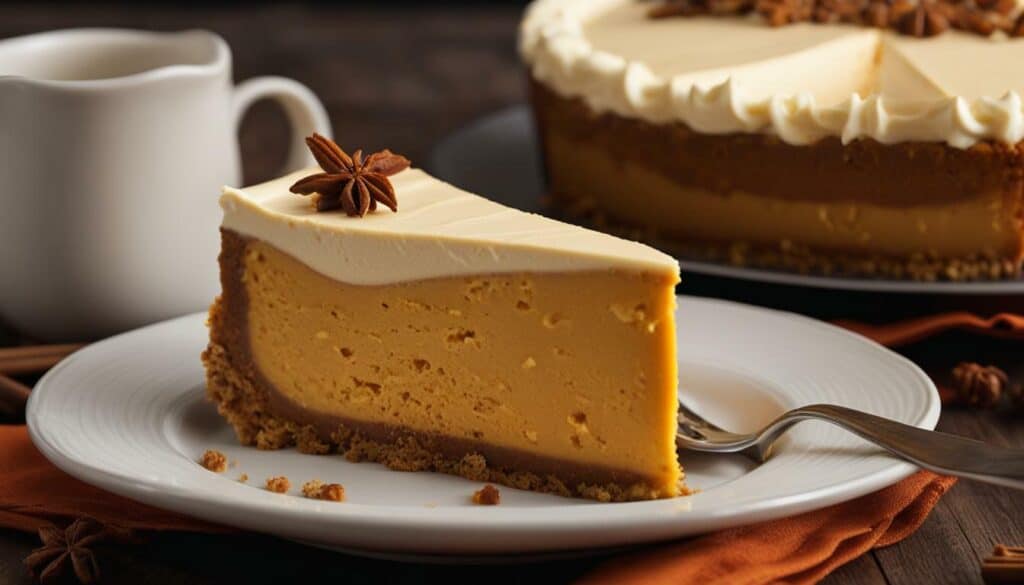
Pumpkin pie, another popular fall dessert, also contains carbohydrates but usually in lower amounts compared to pumpkin cheesecake. A slice of pumpkin pie typically contains around 30-35g of carbohydrates. This is because pumpkin pie does not have the additional cream cheese and heavy cream typically found in pumpkin cheesecake. However, the exact carbohydrate content can vary depending on the recipe and serving size.
Summary
Pumpkin cheesecake is a delicious and indulgent dessert that provides a rich combination of flavors. However, it’s important to be mindful of its carbohydrate content, especially for those with specific dietary needs or goals. Enjoying pumpkin cheesecake in moderation and balancing it with a well-rounded diet is key. If you’re looking for alternatives with lower carbohydrate content, consider trying pumpkin pie or exploring healthier versions of pumpkin cheesecake recipes.
| Nutrients | Pumpkin Cheesecake (per slice) | Pumpkin Pie (per slice) |
|---|---|---|
| Calories | 515 | 300 |
| Carbohydrates | 41g | 30-35g |
| Protein | 7g | 5g |
| Fat | 37g | 14-18g |
Protein in Pumpkin Cheesecake
While pumpkin cheesecake is known for its creamy texture, it also provides a modest amount of protein, with approximately 7g per slice. Protein is an essential macronutrient that plays a crucial role in the maintenance and repair of body tissues, as well as supporting overall health and well-being.
In addition to its protein content, pumpkin cheesecake is also rich in carbohydrates and fats. A slice of pumpkin cheesecake typically contains around 41g of carbohydrates, which provide the body with a source of energy. The fats in pumpkin cheesecake contribute to its rich and indulgent flavor, with approximately 37g of fat per slice.
To provide a comprehensive overview of the nutritional information, including the calorie content of pumpkin cheesecake, here is a table breaking down the key macronutrients:
| Nutrient | Amount per Slice |
|---|---|
| Calories | 515 |
| Carbohydrates | 41g |
| Protein | 7g |
| Fat | 37g |
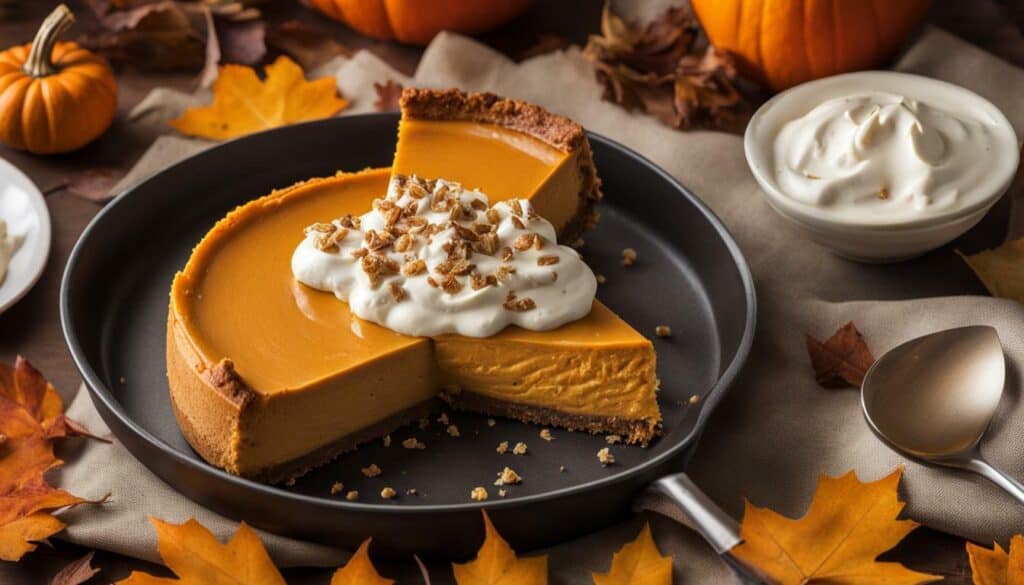
It’s important to note that the nutritional content may vary slightly depending on the specific recipe and serving size. Additionally, moderation is key when enjoying pumpkin cheesecake, as its calorie and fat content can add up quickly. Consider portion control and balancing indulgence with a well-rounded diet and regular physical activity.
For those looking for healthier alternatives, there are recipes available that offer lower calorie and healthier versions of pumpkin cheesecake. Additionally, vegan options are also available, using plant-based ingredients like tofu and cashews as a substitute for cream cheese.
Overall, pumpkin cheesecake can be enjoyed as a delightful treat during the fall season, but it’s essential to be mindful of its nutritional content and consume it in moderation to maintain a balanced diet.
Fat in Pumpkin Cheesecake
The rich and indulgent nature of pumpkin cheesecake contributes to its fat content, with around 37g per slice. This velvety dessert combines the creamy goodness of cream cheese and the smoothness of pumpkin puree, resulting in a delectable treat that is hard to resist.
The combination of cream cheese and heavy cream gives pumpkin cheesecake its luxurious texture and mouthfeel. These ingredients provide the richness that makes each bite satisfyingly decadent. However, it’s important to be mindful of portion sizes, as the fat content can add up quickly.
For those looking to enjoy a lighter version, there are alternative recipes available that offer a healthier twist. Some variations use Greek yogurt or cottage cheese instead of the traditional cream cheese, reducing the overall fat content without compromising on flavor. You can also experiment with using reduced-fat versions of cream cheese and heavy cream to further reduce the fat content.
| Calories | Carbohydrates | Protein | Fat |
|---|---|---|---|
| 515 | 41g | 7g | 37g |
Remember, while pumpkin cheesecake is undeniably delicious, it’s important to enjoy it in moderation. Indulging in a slice or two during special occasions can be a delightful treat. Pair it with a cup of hot coffee or tea for a cozy and comforting experience. So go ahead, savor the flavors of fall and relish every bite of this delightful dessert.
Healthy Pumpkin Cheesecake Alternatives
If you’re looking to enjoy the flavors of pumpkin cheesecake while reducing the calorie content, there are healthier alternatives available. These options allow you to indulge in a delicious dessert without feeling guilty. Whether you have specific dietary preferences or simply want a lighter version of this classic treat, there are recipes that cater to your needs.
For those seeking a low-calorie pumpkin cheesecake, consider replacing the traditional cream cheese filling with a combination of Greek yogurt and reduced-fat cream cheese. This swap significantly reduces the fat content while still maintaining the creamy texture and tangy flavor. Additionally, using a whole grain crust made with crushed oatmeal cookies or almond flour instead of regular graham crackers adds fiber and nutrients to the dessert.
Vegan pumpkin cheesecake options are also available for those following a plant-based diet. These recipes typically use tofu or cashews as a base for the creamy filling, combined with pumpkin puree and plant-based sweeteners. The result is a dairy-free and egg-free version of pumpkin cheesecake that is just as decadent and satisfying as the traditional recipe.
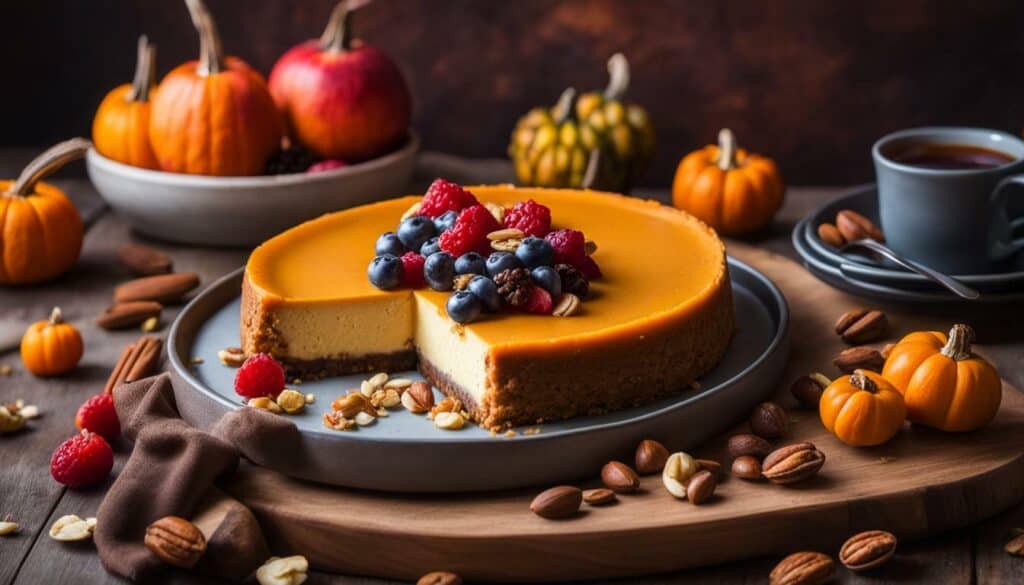
Experimenting with different ingredients and techniques can lead to even more creative and nutritious alternatives. Consider adding spices like cinnamon, nutmeg, or ginger for extra flavor, or replacing sugar with natural sweeteners like maple syrup or dates. You can also incorporate additional toppings such as chopped nuts, fresh fruit, or a drizzle of dark chocolate to enhance the presentation and taste.
| Alternative | Calories per Slice | Carbohydrates (g) | Protein (g) | Fat (g) |
|---|---|---|---|---|
| Low-Calorie Greek Yogurt Pumpkin Cheesecake | 320 | 26 | 12 | 18 |
| Vegan Tofu Pumpkin Cheesecake | 280 | 32 | 8 | 14 |
| Almond Flour Crust Pumpkin Cheesecake | 350 | 22 | 10 | 24 |
If you’re conscious about your calorie intake or follow a specific diet, these healthier pumpkin cheesecake alternatives can still satisfy your dessert cravings without compromising on taste. With a few ingredient swaps and modifications, you can enjoy a guilt-free treat that is both delicious and nutritious.
Vegan Pumpkin Cheesecake Options
For those following a vegan lifestyle, there are pumpkin cheesecake recipes that use tofu and cashews instead of traditional cream cheese. This allows vegans to enjoy the delicious flavors of pumpkin cheesecake while staying true to their dietary choices. These vegan alternatives offer a creamy and indulgent dessert that is equally satisfying.
To make a vegan pumpkin cheesecake, you can start by blending silken tofu and soaked cashews together until smooth. This creates a creamy base that mimics the texture of traditional cheesecake. Then, add in pumpkin puree, maple syrup, coconut oil, vanilla extract, and pumpkin pie spice to enhance the pumpkin flavor. Blend all the ingredients together until well combined.
Next, prepare a crust using crushed vegan graham crackers, coconut oil, and a touch of maple syrup for sweetness. Press the crust mixture into the bottom of a springform pan to create a solid base for the cheesecake. Pour the pumpkin cheesecake filling on top of the crust and smooth it out with a spatula. Bake the cheesecake in the oven at 350°F (175°C) for about 40-45 minutes, or until the center is set.
Once the vegan pumpkin cheesecake is done baking, let it cool completely before refrigerating it for at least 6 hours or overnight. This chilling time allows the flavors to meld together and the cheesecake to set properly. When ready to serve, remove the cheesecake from the pan and garnish with whipped coconut cream, chopped pecans, or a sprinkle of cinnamon. Each slice of vegan pumpkin cheesecake is a delectable treat with the rich flavors of pumpkin and spices.
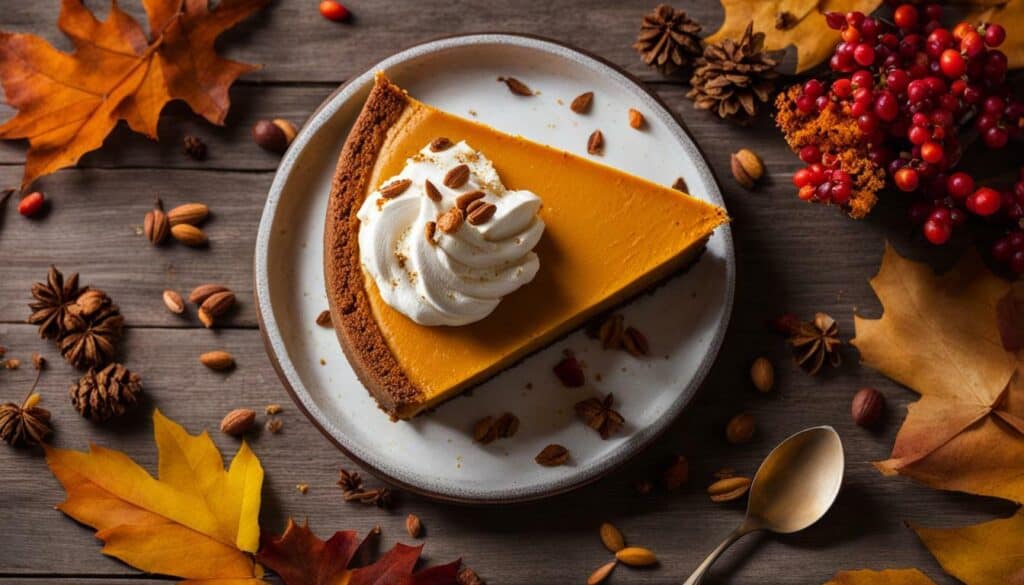
| Calories | Carbohydrates | Protein | Fat |
|---|---|---|---|
| 215 | 27g | 4g | 11g |
Serving Size and Indulgence
While pumpkin cheesecake can be a delicious treat, it’s important to keep in mind the recommended serving size to avoid excessive calorie intake. A typical serving of pumpkin cheesecake is around 1/12th of a 9-inch cheesecake, which is equivalent to one slice. This portion size allows you to enjoy the rich flavors and creamy texture without going overboard on calories.
When serving pumpkin cheesecake, it can be tempting to indulge in larger portions, especially during the holiday season. However, by practicing mindful eating and portion control, you can savor the taste of pumpkin cheesecake while still maintaining a balanced diet.
Here are some tips to help you enjoy pumpkin cheesecake in moderation:
- Use a smaller dessert plate or bowl to visually trick your mind into thinking you’re having a larger portion.
- Savor each bite and eat slowly, allowing yourself to truly enjoy the flavors and textures of the cheesecake.
- Pair your slice of pumpkin cheesecake with a side of fresh fruit or a light salad to add volume to your plate without adding excessive calories.
- Consider sharing a slice with a friend or family member to satisfy your cravings without consuming a full serving.
By being mindful of serving sizes and practicing moderation, you can indulge in the deliciousness of pumpkin cheesecake while still maintaining a healthy and balanced lifestyle.
Pumpkin Cheesecake Serving Size
It’s important to note that the calorie content and nutritional information provided for pumpkin cheesecake are based on the recommended serving size of one slice. Deviating from this serving size may result in higher calorie intake. So, enjoy your pumpkin cheesecake in moderation and savor every bite!
| Nutrient | Amount per Serving |
|---|---|
| Calories | Approximately 515 |
| Carbohydrates | 41g |
| Protein | 7g |
| Fat | 37g |
Remember, it’s all about balance and enjoying your favorite indulgences in moderation. So, go ahead and savor a slice of pumpkin cheesecake, while keeping an eye on the serving size to ensure a guilt-free enjoyment!
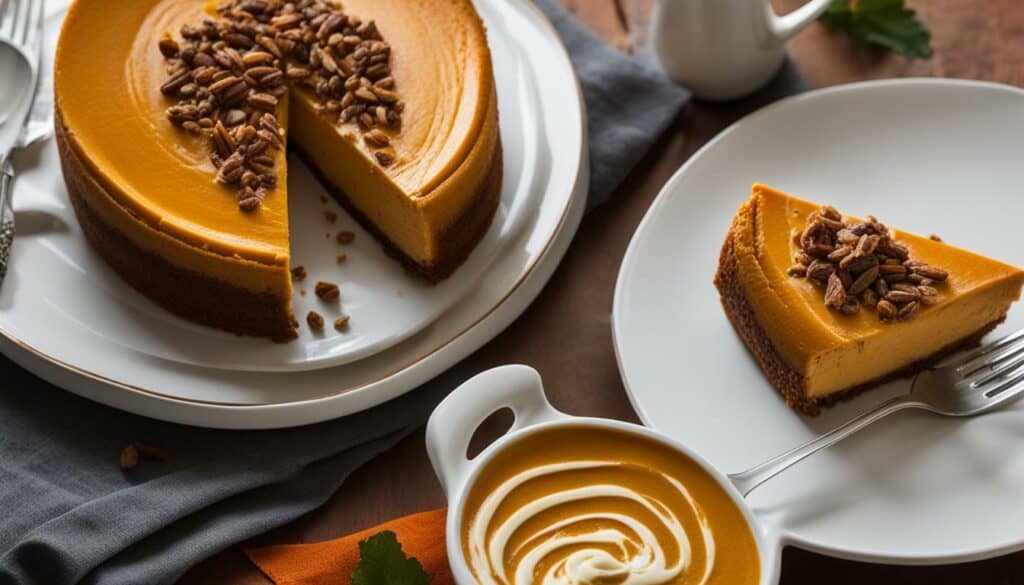
It’s okay to indulge in a slice of pumpkin cheesecake during special occasions, but being mindful of portion size and overall calorie intake is important. While pumpkin cheesecake is undeniably delicious, it can also be quite calorie-dense. One slice of traditional pumpkin cheesecake can contain around 515 calories, which can add up quickly if you’re not careful.
In order to enjoy pumpkin cheesecake without derailing your healthy eating goals, consider these tips. First, be aware of your portion size. One slice is usually enough to satisfy your sweet tooth. Secondly, balance your indulgence by being mindful of your overall calorie intake for the day. It’s best to enjoy a slice of pumpkin cheesecake as part of a well-balanced diet that includes plenty of fruits, vegetables, and lean proteins.
If you’re looking for a healthier alternative, there are options available. You can try making a low-calorie version of pumpkin cheesecake by using alternative ingredients. For example, you can use Greek yogurt or cottage cheese instead of cream cheese, and opt for a lighter crust made with crushed nuts or oats instead of traditional graham crackers. These substitutions can significantly reduce the calorie content without sacrificing flavor.
Table: Nutritional Information of Pumpkin Cheesecake
| Calories | Carbohydrates | Protein | Fat |
|---|---|---|---|
| 515 | 41g | 7g | 37g |
While it’s important to enjoy pumpkin cheesecake in moderation, it’s equally important to savor every bite. Remember that indulging in a slice of this decadent dessert can bring joy and satisfaction. So, whether you choose to stick to the traditional recipe or opt for a healthier version, take the time to appreciate the flavors and the special moments shared with loved ones.
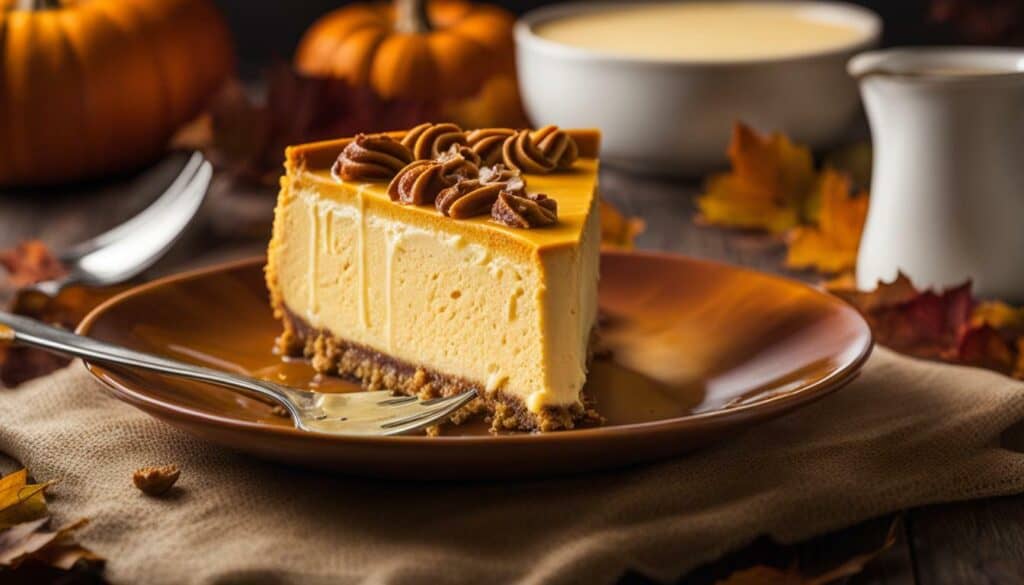
Pumpkin cheesecake is a delicious dessert that can be enjoyed in moderation, with an average slice containing around 515 calories. However, there are healthier alternatives and vegan options available for those looking to watch their calorie intake without sacrificing taste.
If you’re conscious of your calorie consumption, you can opt for healthier pumpkin cheesecake alternatives. These recipes often use substitutions like Greek yogurt instead of cream cheese, almond flour for the crust, and natural sweeteners like maple syrup or stevia. By making these simple changes, you can significantly reduce the calorie content of your pumpkin cheesecake while still enjoying its delightful flavors.
For those following a vegan lifestyle, there are also fantastic options to satisfy your pumpkin cheesecake cravings. Vegan pumpkin cheesecakes typically use a combination of tofu and cashews to achieve that creamy texture, while still incorporating the familiar pumpkin and spice flavors. These recipes are not only lower in calories but also free from dairy and eggs.
Whether you choose the traditional recipe or explore healthier and vegan alternatives, remember that indulgence can be part of a balanced lifestyle. Enjoy a slice of pumpkin cheesecake while being mindful of portion sizes and overall calorie intake. By practicing moderation, you can savor this seasonal treat without guilt, knowing that there are options available that cater to your dietary preferences and goals.
FAQ
Q: How many calories are in a slice of pumpkin cheesecake?
A: A slice of pumpkin cheesecake contains approximately 515 calories.
Q: What are the main ingredients in pumpkin cheesecake?
A: The main ingredients in pumpkin cheesecake include cream cheese, sugar, eggs, pumpkin puree, heavy cream, vanilla, and pumpkin pie spice.
Q: How long does it take to bake a pumpkin cheesecake?
A: Pumpkin cheesecake typically takes about an hour to bake in a water bath.
Q: How should I serve pumpkin cheesecake?
A: Pumpkin cheesecake can be served with whipped cream, caramel sauce, or ice cream for added deliciousness.
Q: Are there any healthier alternatives to traditional pumpkin cheesecake?
A: Yes, there are alternative recipes available for healthier pumpkin cheesecake options. These may include low-calorie or vegan versions.
Q: What is the carbohydrate content in pumpkin cheesecake?
A: A slice of pumpkin cheesecake contains about 41 grams of carbohydrates.
Q: How much protein does pumpkin cheesecake have?
A: A slice of pumpkin cheesecake has approximately 7 grams of protein.
Q: How much fat is in pumpkin cheesecake?
A: Pumpkin cheesecake contains about 37 grams of fat per slice.
Q: Can I make a vegan version of pumpkin cheesecake?
A: Yes, there are vegan versions of pumpkin cheesecake available that use tofu and cashews instead of cream cheese.
Q: How should I enjoy pumpkin cheesecake in moderation?
A: It’s important to practice portion control and mindful indulgence when enjoying pumpkin cheesecake to maintain a balanced diet.
Are Keto Yogurts a Healthy Option for My Diet?
Are Keto Yogurts a Healthy Option for My Diet? Let’s explore the keto yogurt nutrition facts unveiled for you. Keto yogurts are low in carbohydrates and high in healthy fats and proteins, making them a popular choice for those on a ketogenic diet. Packed with probiotics, vitamins, and minerals, they can support gut health and boost immunity. However, it’s important to check labels for added sugars or artificial sweeteners, as they may hinder your health goals. Incorporating keto yogurts into your diet can be a nutritious choice if consumed in moderation and alongside a balanced meal plan.

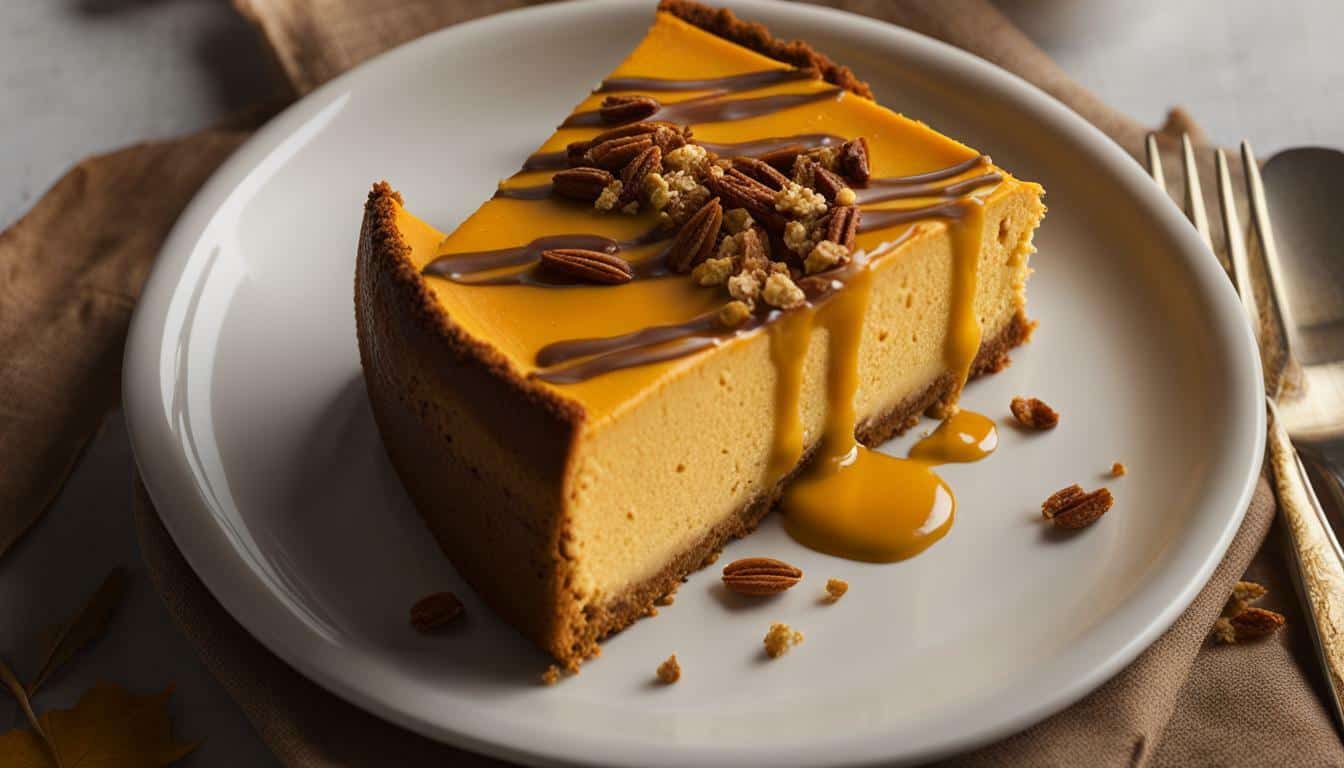



Leave a Reply